Featured Comment:
“There are many abura soba and mazesoba recipes on YouTube and I wish I’d seen yours much earlier because it’s the best and most kitchen friendly. Thanks for making the recipe available for us ramen freaks.”
– Mike
What is “Abura Soba”?
Abura soba (油そば) is a type of ramen dish that features noodles and a variety of toppings served on top of a rich and flavorful sauce known in Japanese as “tare” (たれ).
Before eating, it is important to thoroughly mix the ingredients until they are evenly coated in the sauce. Often, vinegar and chili oil are added to enhance the taste.
What distinguishes this dish from traditional ramen is the absence of a soupy broth. Nonetheless, it more than compensates for this by delivering a delectable explosion of flavors.
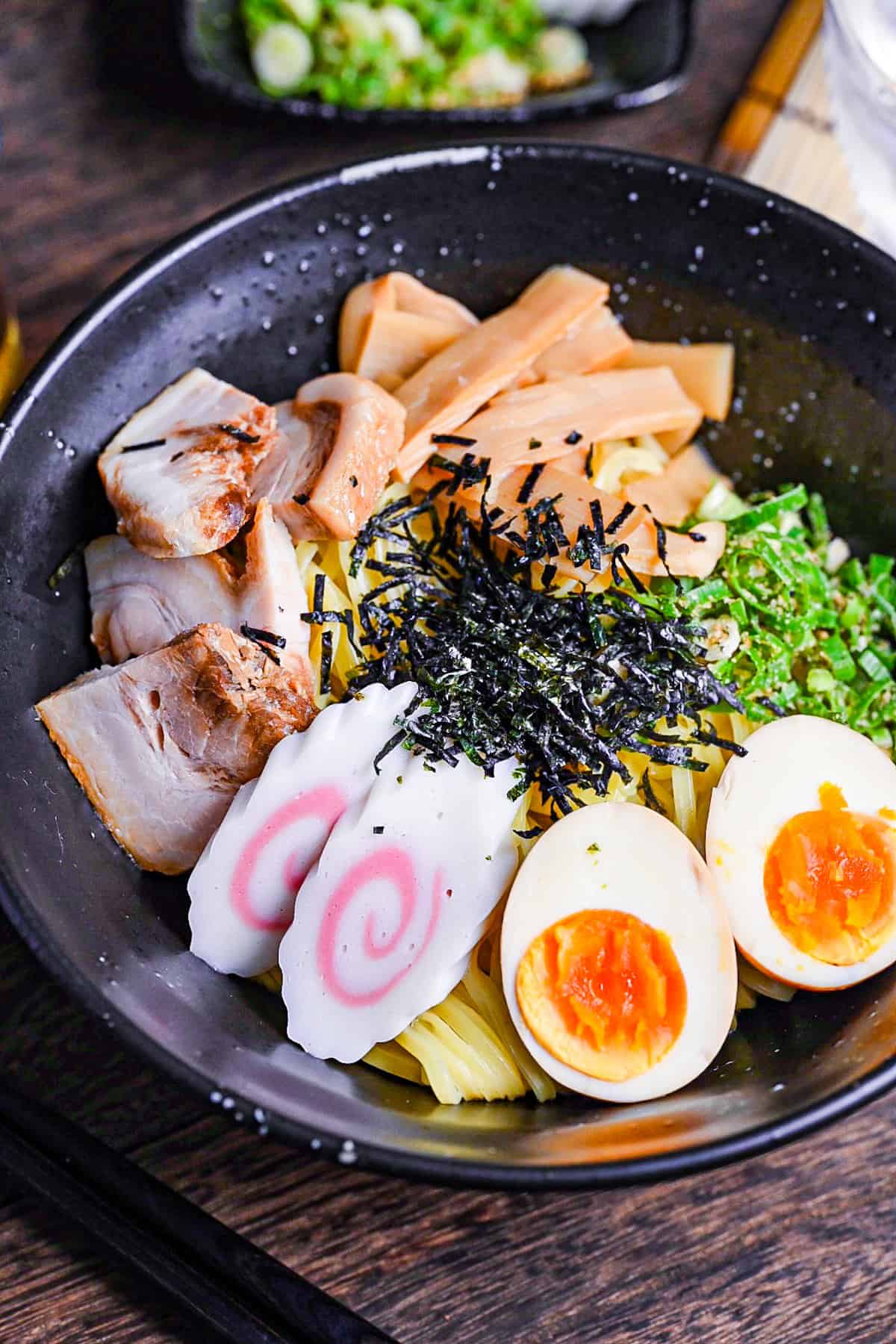

How I Developed This Recipe
If you have seen my Shio Ramen and Shoyu Ramen recipes, you already know that creating authentic ramen from scratch can require a lot of time and effort.
With abura-soba, I saw an opportunity. Given its soup-less nature, I pondered on how I could streamline the process without compromising on authenticity. After much experimentation and tweaking, I’m proud to present a recipe that strikes the perfect balance.
It’s a delightful blend of ease and authenticity, capturing the essence of abura-soba in a fraction of the time.
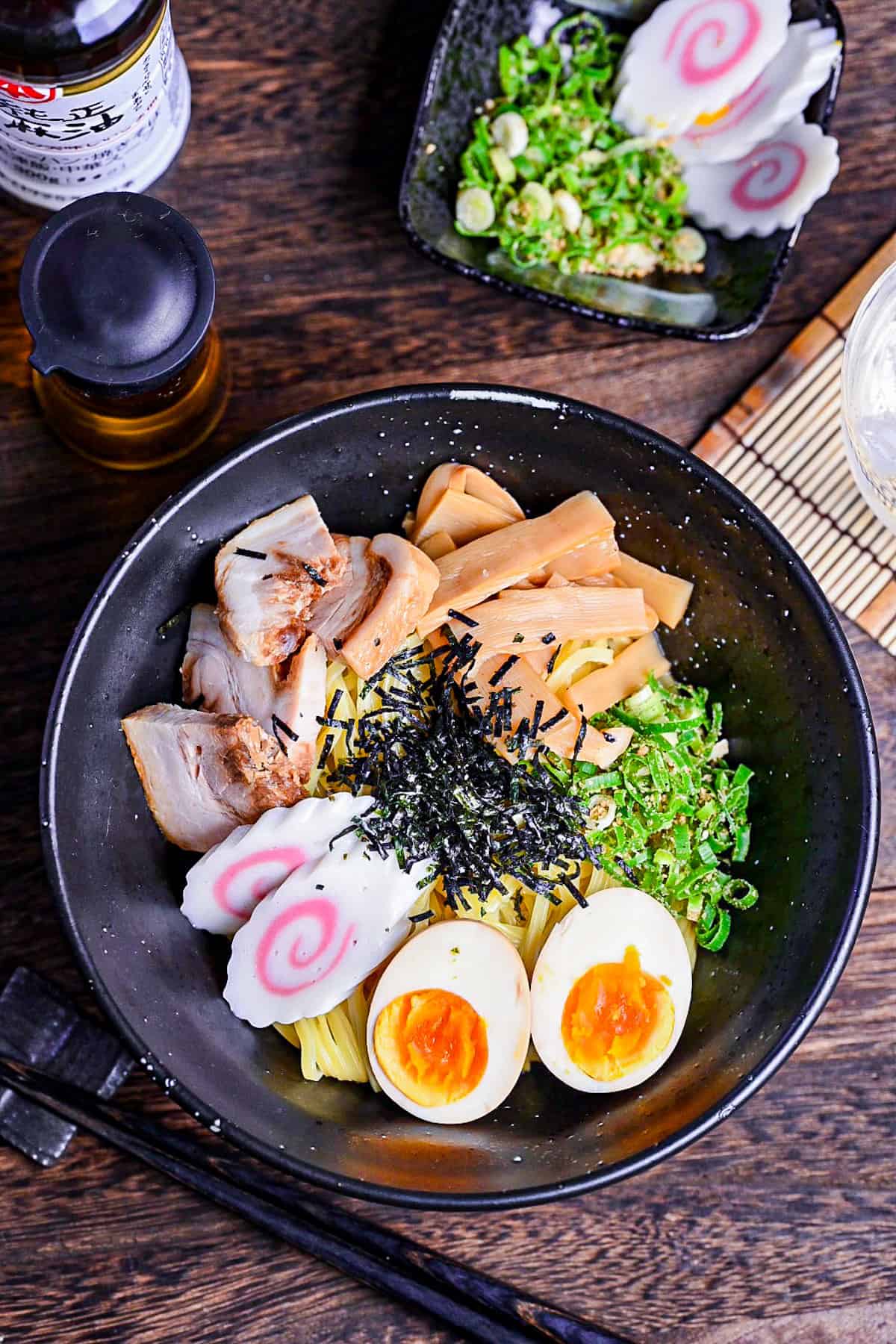
Visual Walkthrough & Tips
Here are my step-by-step instructions for how to make Abura Soba at home. For ingredient quantities and simplified instructions, scroll down for the Printable Recipe Card below.
If you prefer to watch the process in action, check out my YouTube video of this abura soba recipe for a complete visual walkthrough!
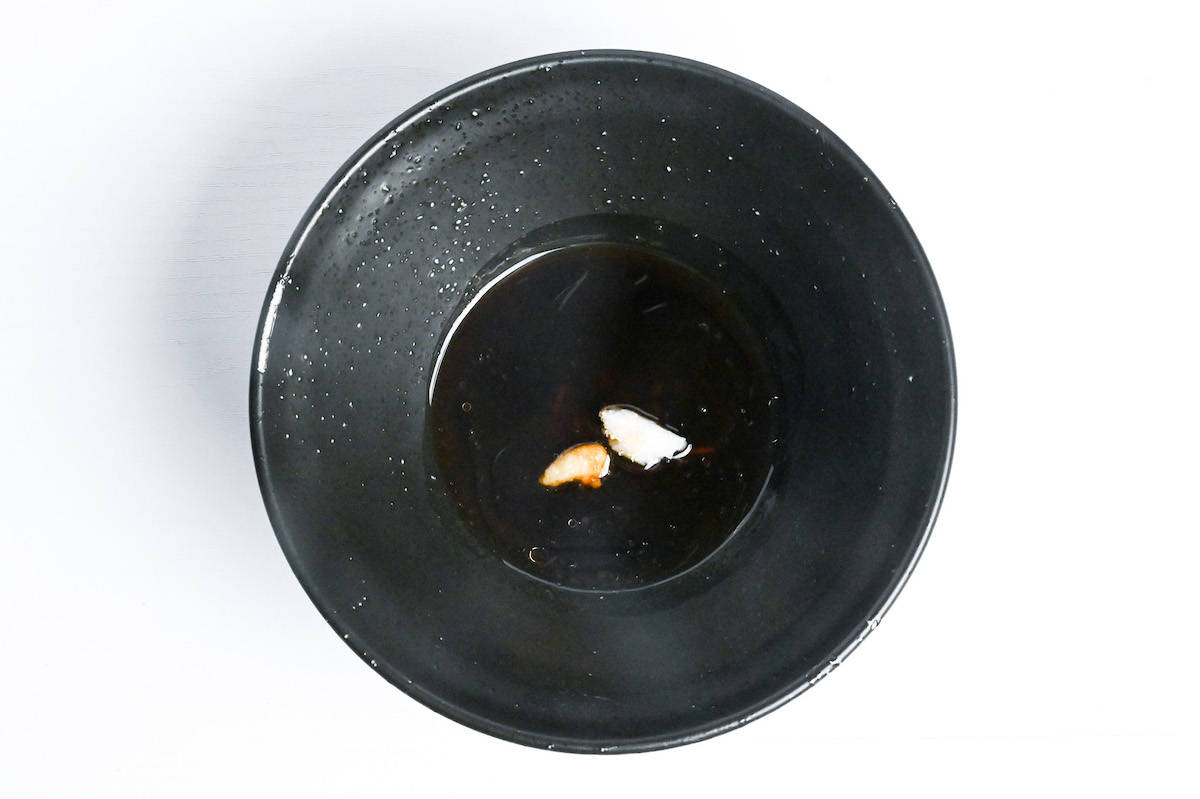
The tare sauce is the heart of Abura Soba. Grab your noodle bowls, and in each one, pour water, oyster sauce, soy sauce, rice vinegar, and sesame oil. Add chicken stock powder, lard, garlic paste, and light brown sugar. Give it a good mix.
Note: Make sure to use microwavable bowls since we will heat the tare later.
Mix your tare ingredients in a jug rather than having to measure out each bowl individually. Just make sure to divide it equally later!
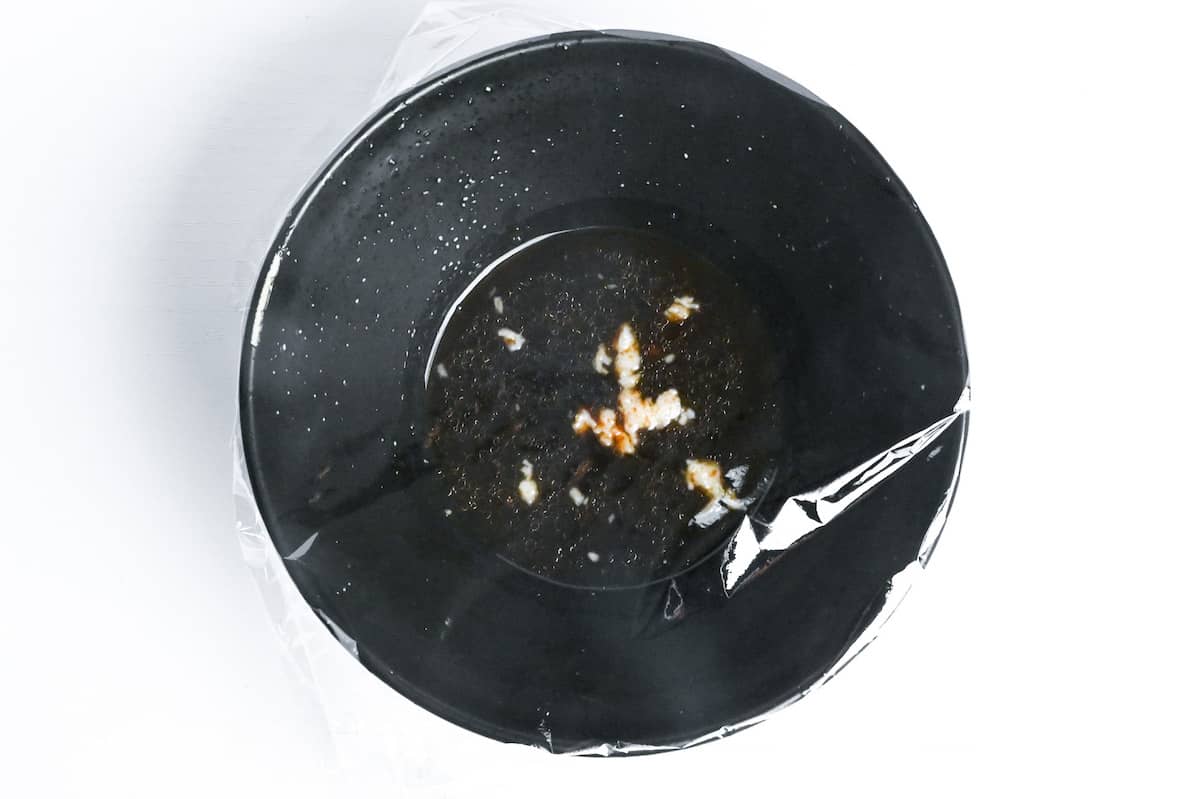
Cover the bowls with plastic wrap, then set aside for now.
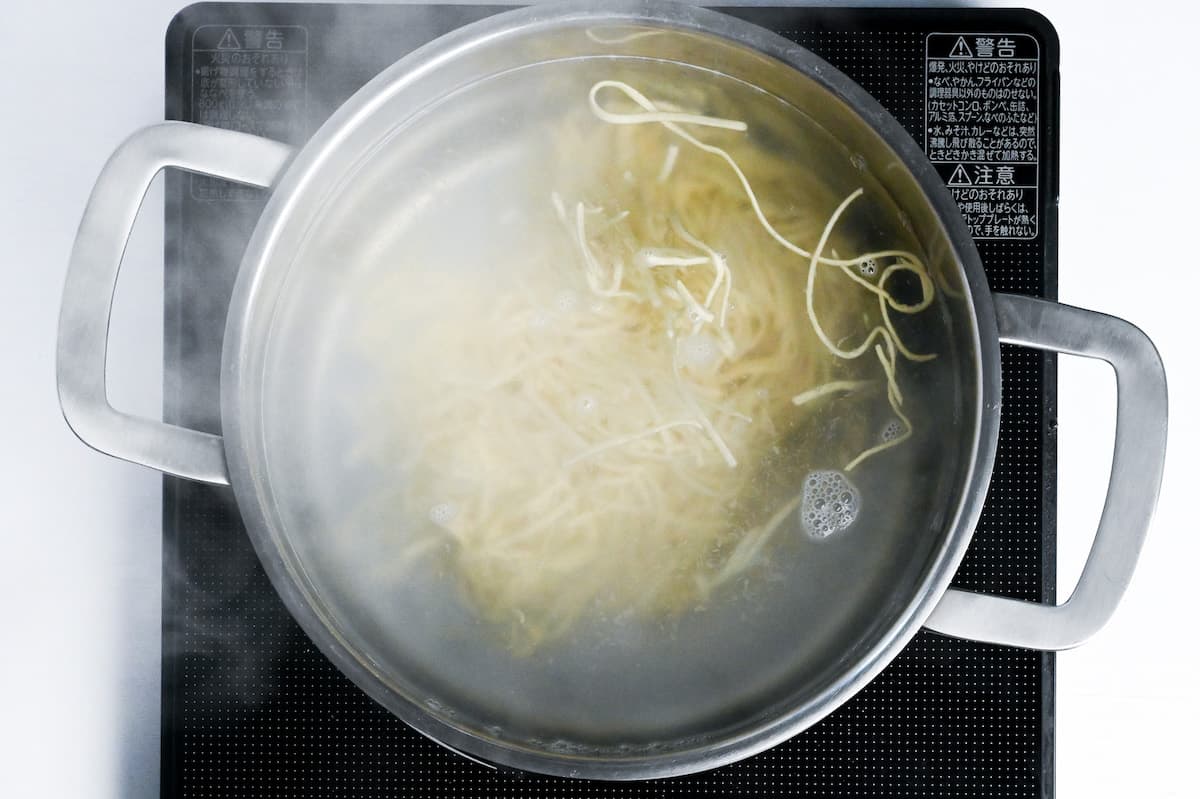
Boil ramen noodles as per the instructions on the packaging (or a little less). Make sure you use a large pot of water to allow the noodles plenty of room to move.
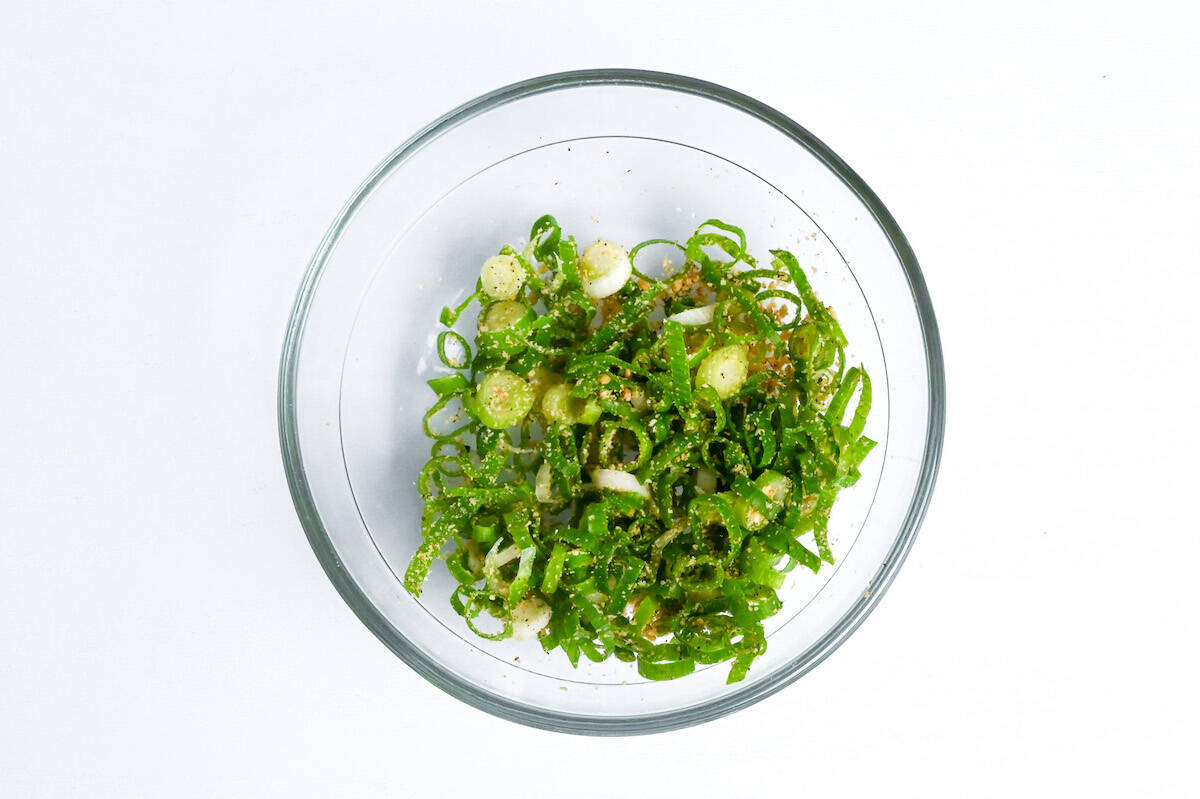
While they’re cooking, let’s prep the toppings. Mix chopped green onions, ground sesame seeds, and black pepper in a separate bowl. This mix adds a delicious flavor to the dish.
You can also use this time to slice your chashu, narutomaki and prepare the toppings of your choice.
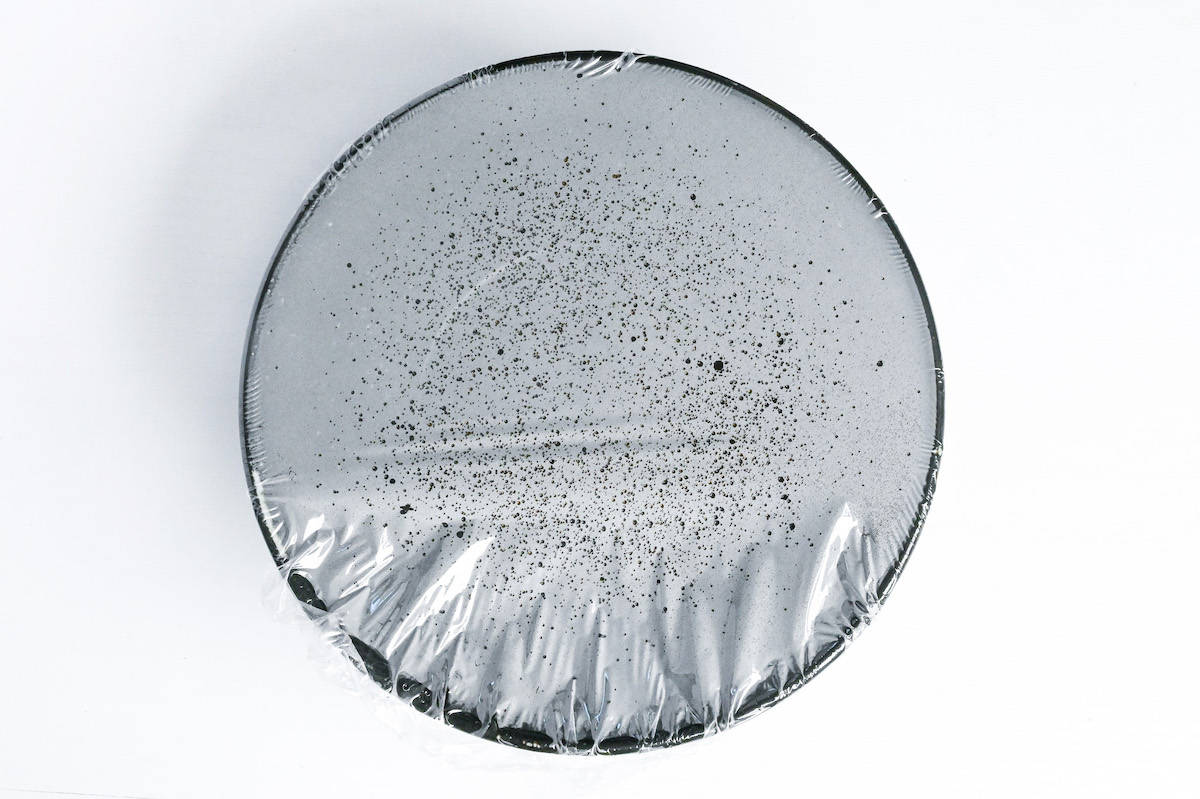
When there’s just 1 minute left for the noodles to cook, pop the covered bowls with tare into the microwave.
Heat them for 1 minute at 600W. This warms the sauce through and helps the ingredients dissolve and meld together, ensuring even flavor when mixed with the noodles.
If making a large batch in a jug, increase the microwave time accordingly.
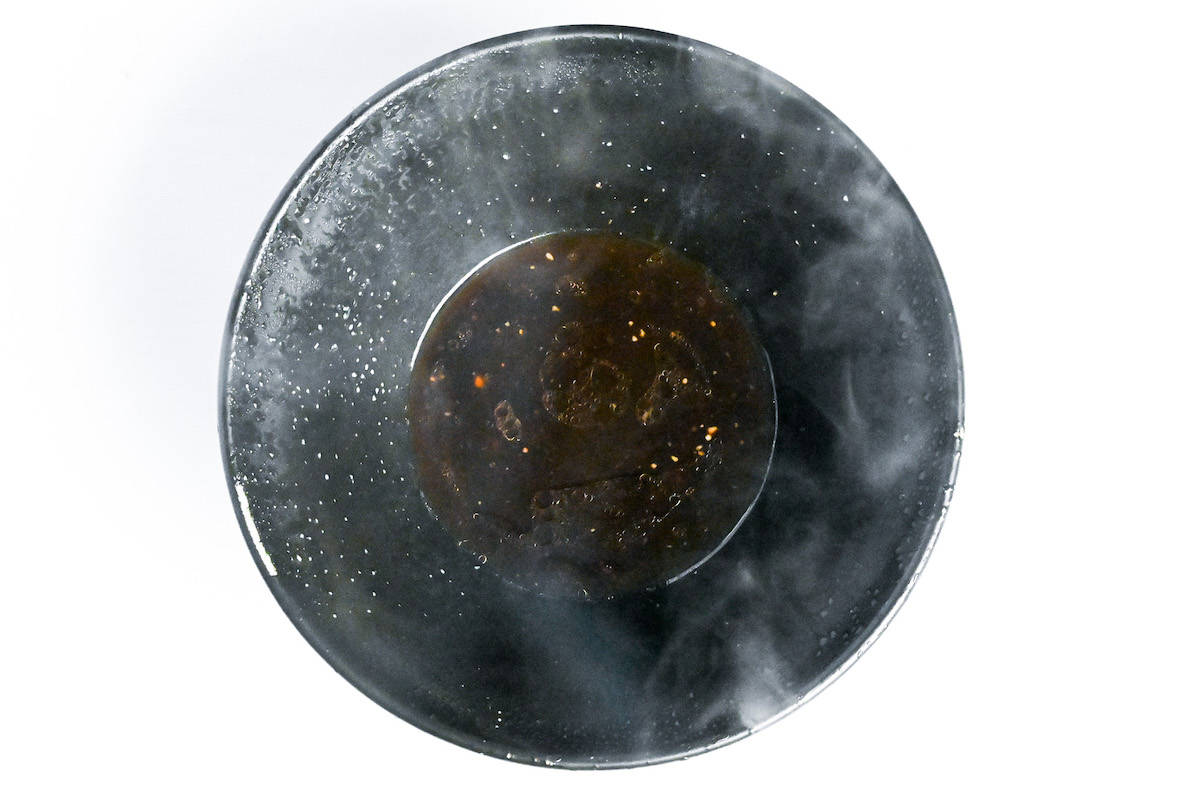
Once done, carefully remove the bowls from the microwave, remove the plastic wrap and give it a final mix.
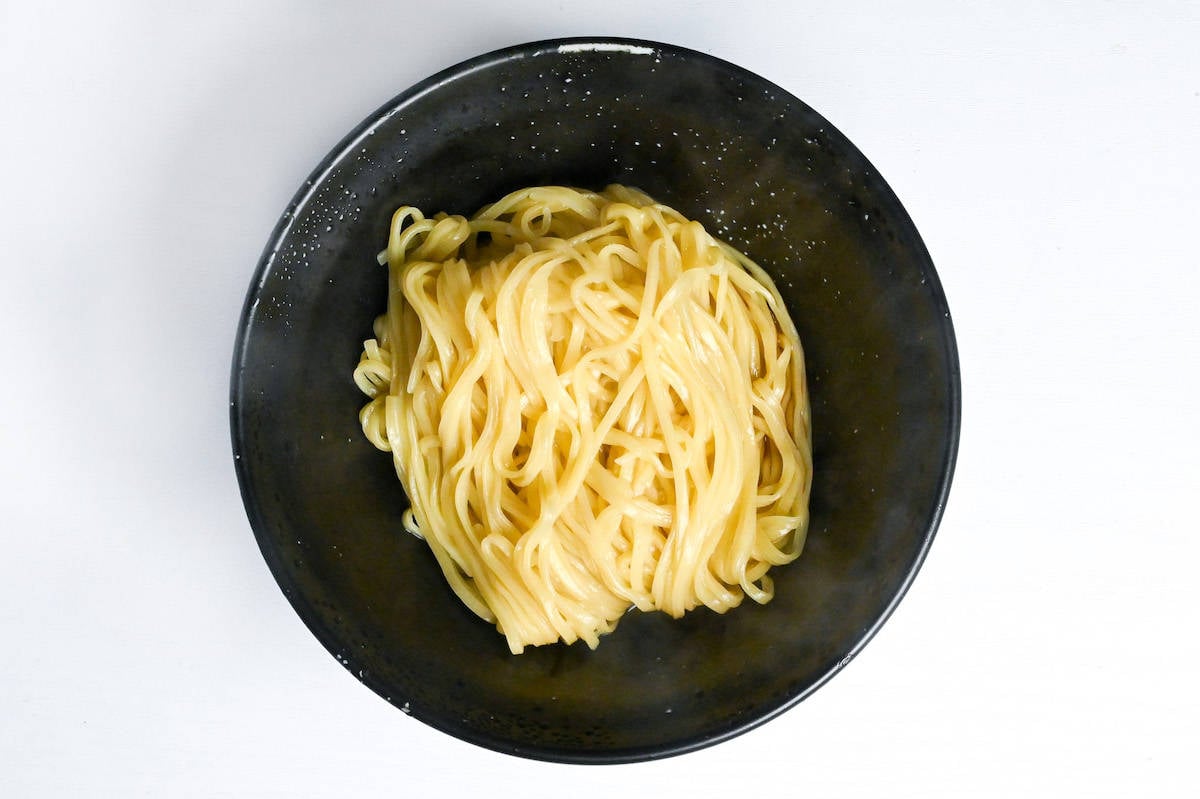
Drain the cooked noodles using a sieve or colander and rinse with fresh hot water to remove any excess starch. Divide them between the serving bowls, placing them directly on top of the tare.
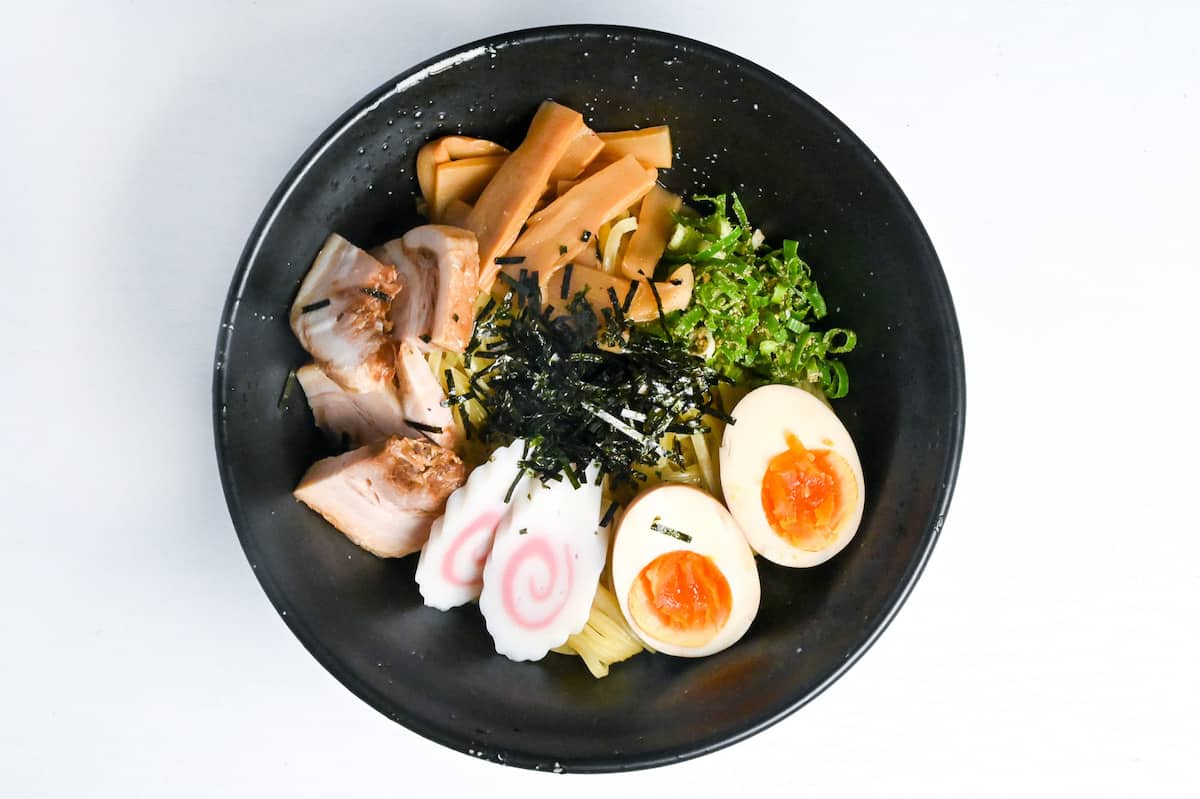
Now, for the fun part! Arrange slices of pork chashu, ramen eggs, bamboo shoots, and narutomaki over the noodles. Garnish with nori seaweed for that extra touch.
Abura soba is one dish with its own set of “rules” recommended to be followed to savor the dish to the max. Though these rules may differ from one restaurant to another, here are some common steps to apply to your homemade abura soba!
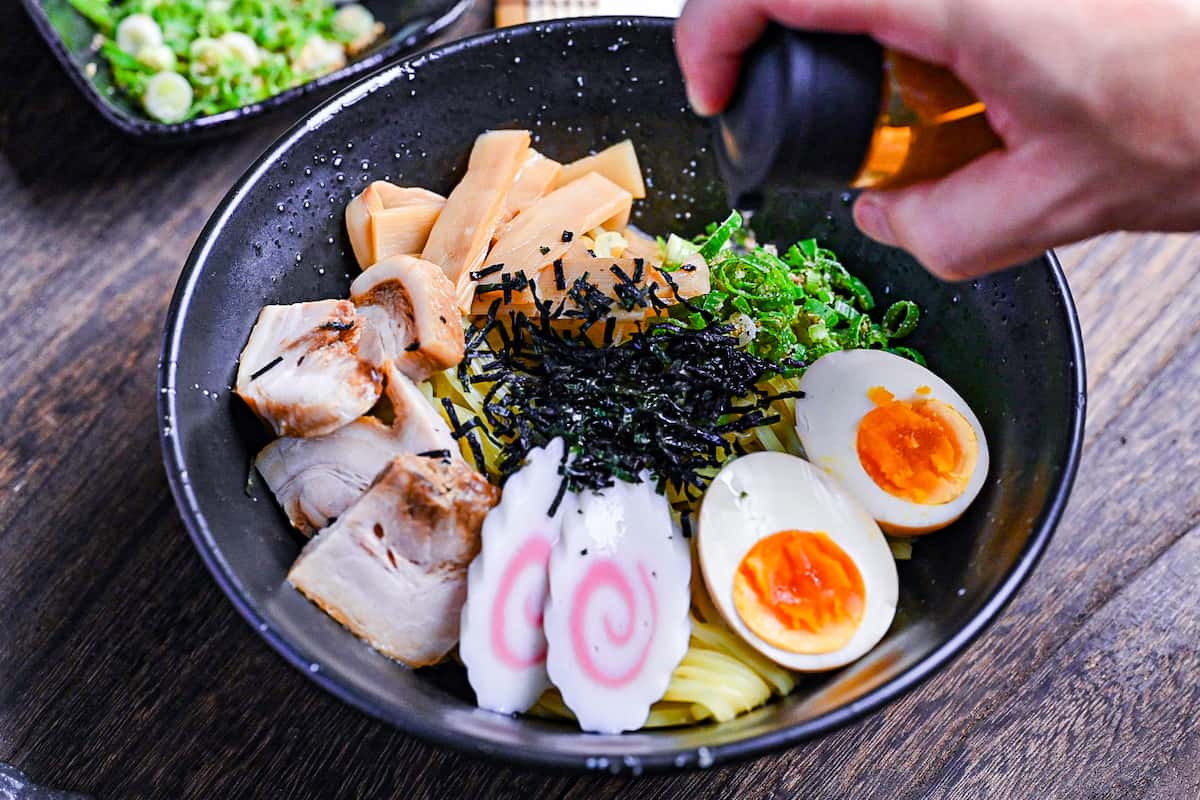
Firstly, add vinegar to the bowl. You can pour a dash of rice vinegar on a regular serving to add balance to the dish. The amount you add depends on preference, but add a little at a time to ensure you don’t overdo it.
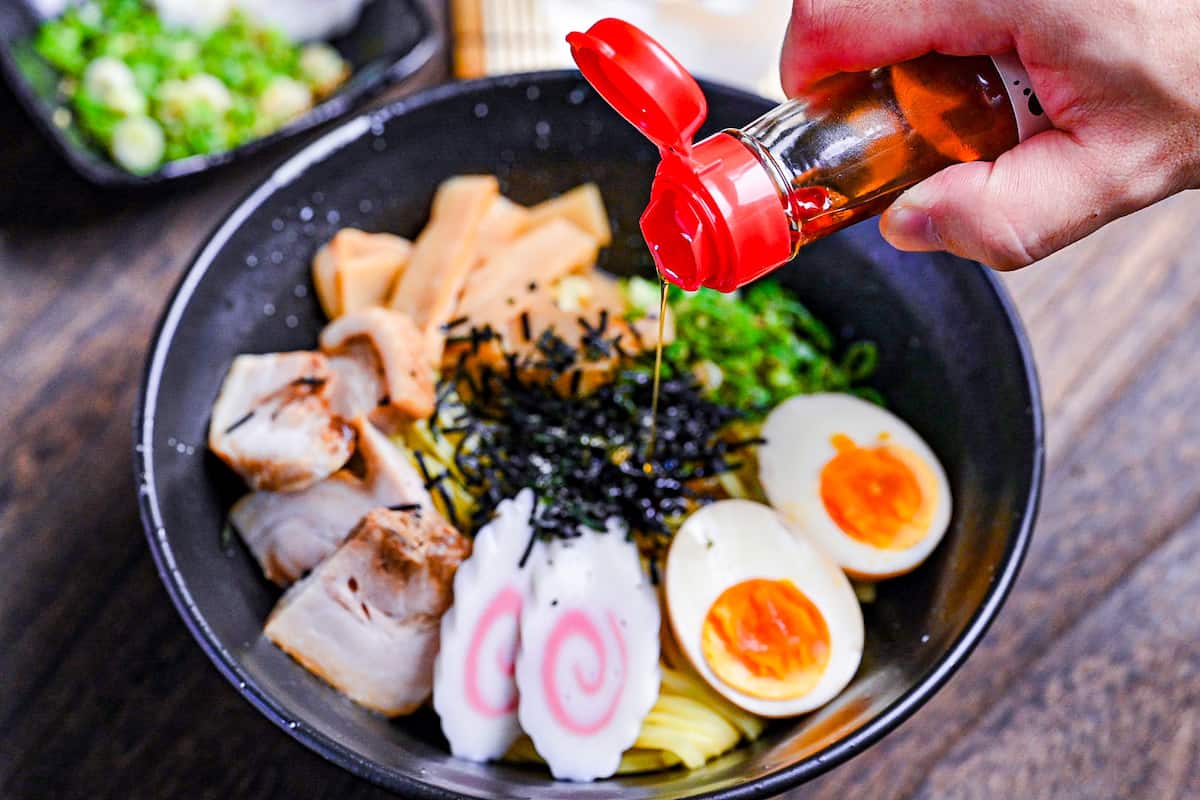
Next, pour sesame-based chili oil (raayu) over the bowl. The amount of chili oil should be roughly the same as vinegar. Adjust the amount according to your taste and spice tolerance.
If you don’t like spicy food, you could substitute this with plain sesame oil.
Jump to Full Recipe Measurements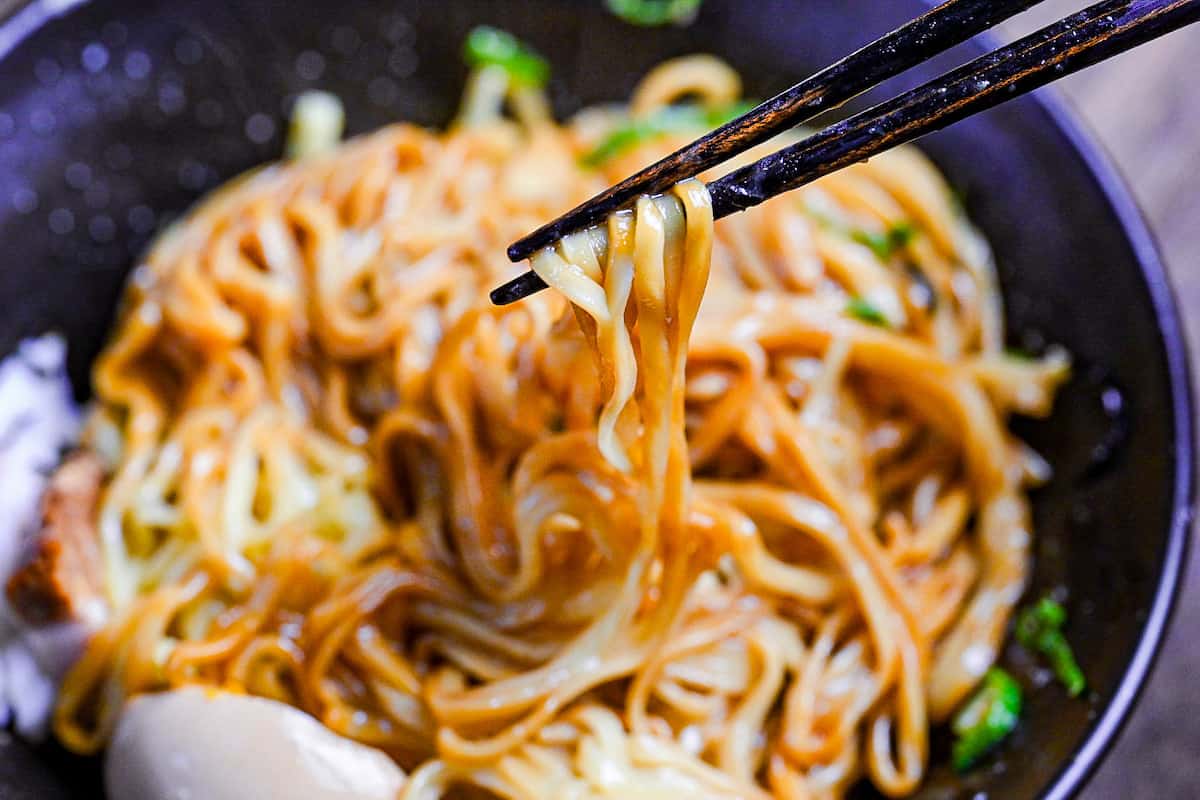
Mixing the ingredients and sauce thoroughly is essential to avoid uneven taste. This step is crucial and should not be skipped. It may look messy, but that’s the beauty of abura soba!
Lastly, make sure to eat while it’s hot. Abura soba tends to lose its flavor as it cools down. Serve it hot with vinegar and raayu.
You should add the vinegar and raayu at the beginning before mixing so that they can combine well with the hot noodles that heat up the sauce. Adding them later will result in uneven flavor.
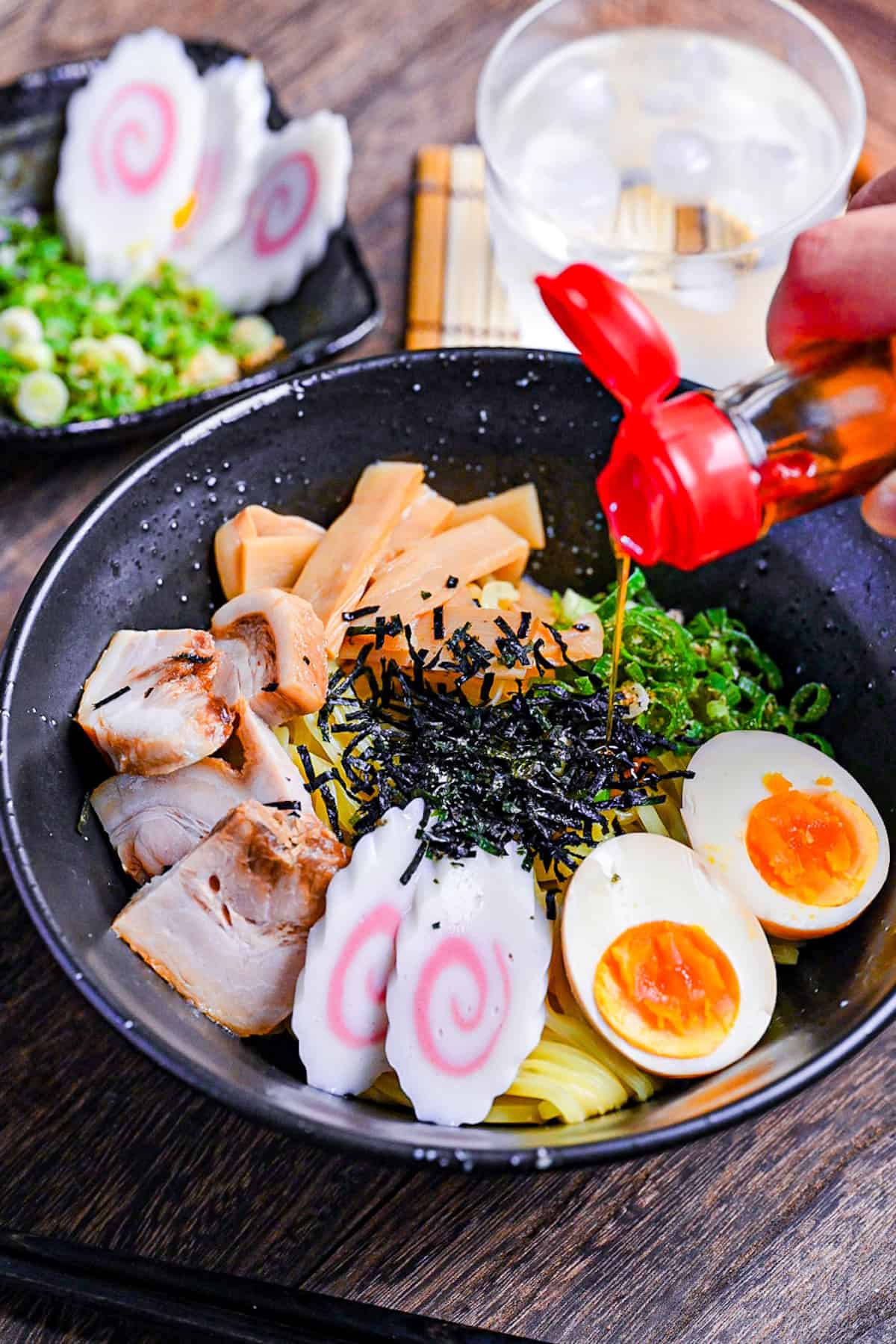
FAQ
Abura soba is a dish that is believed to have originated in Tokyo in the mid-1950s. There are two theories about its origins.
The first theory suggests that abura soba was first served at a restaurant near Hitotsubashi University in Kunitachi, Tokyo around 1953.
The second theory states that it was created in a restaurant near Asia University in Musashino, also located in Tokyo. Since these two universities are only about a 30-minute train ride away from each other, it is reasonable to assume that abura soba originated from that general area.
The Japanese word “abura” means “oil,” which is reflected in the name of the dish “abura soba.” However, contrary to the name, the dish is not that oily. In fact, only a small amount of oil is used in the dish. It is essentially a soupless version of ramen, made with the same noodles and toppings as a typical ramen dish. Therefore, a more accurate translation for “abura soba” would be “soupless ramen”.
Different names are used for the dish, including Monja soba (もんじゃそば), Maze soba (まぜそば), Tenuki soba (手抜きそば), and Abu ramen (あぶらーめん). The specific name depends on the restaurant or region, and may also depend on the sauce or toppings used. The name “mazesoba” (混ぜそば) or “mixed soba” actually originated in Aichi, where I live.
The name “abura soba” is quite misleading as they are not made with soba noodles. In Japanese, ramen noodles are sometimes referred to as “Chinese noodles” (chuukamen / 中華麺) or “Chinese soba” (Chuuka Soba / 中華そば). Therefore, the “soba” part of the name means “chuuka soba” and not buckwheat soba noodles. In general, ramen noodles made with wheat flour and cooked in lye are used for abura soba.
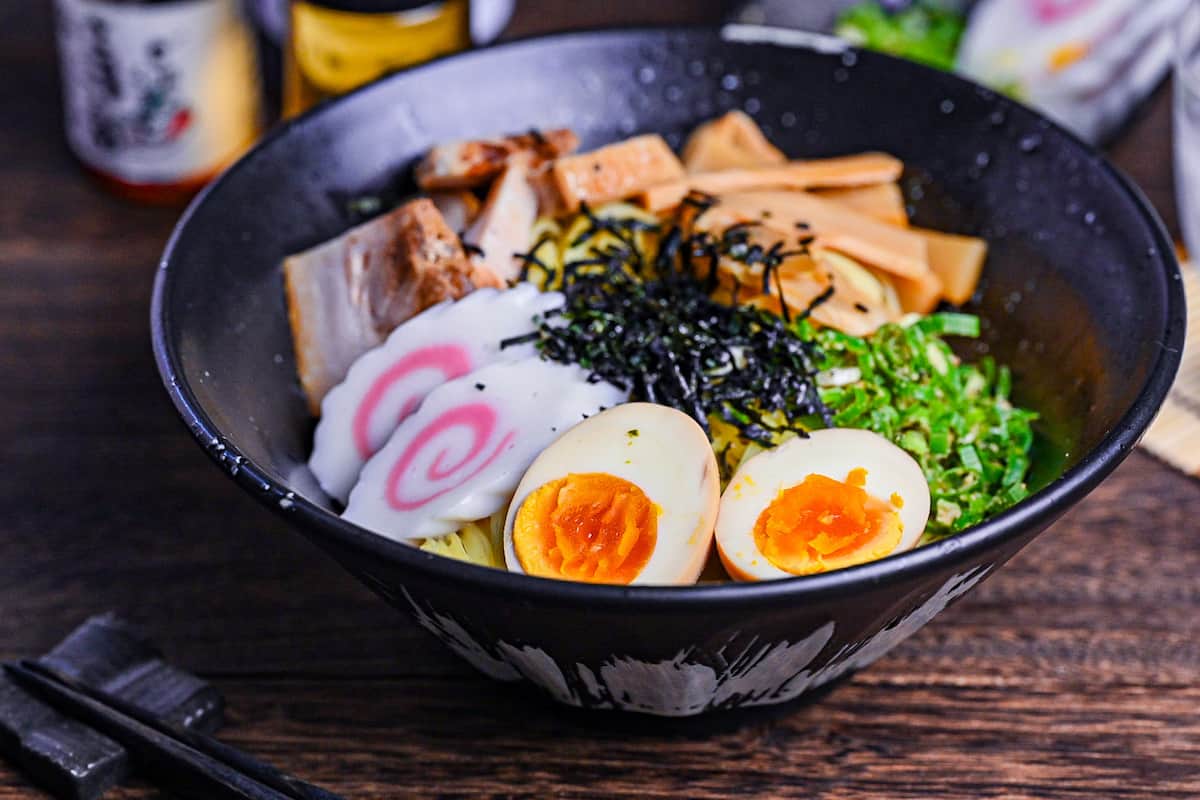
I hope you enjoy this Abura Soba recipe! If you try it out, I’d really appreciate it if you could spare a moment to let me know what you thought by giving a review and star rating in the comments below. It’s also helpful to share any adjustments you made to the recipe with our other readers. Thank you!
More Ramen Recipes
- Miso Ramen
- Taiwan Mazesoba (Nagoya Style Spicy Brothless Ramen)
- Spicy Tsukemen (Dipping Ramen with Spicy Homemade Sauce)
- Hiyashi Chuka (Ramen Salad with Vinegar-Based Sauce)
Want more inspiration? Explore my Ramen Recipe Roundup for a carefully selected collection of tasty recipe ideas to spark your next meal!
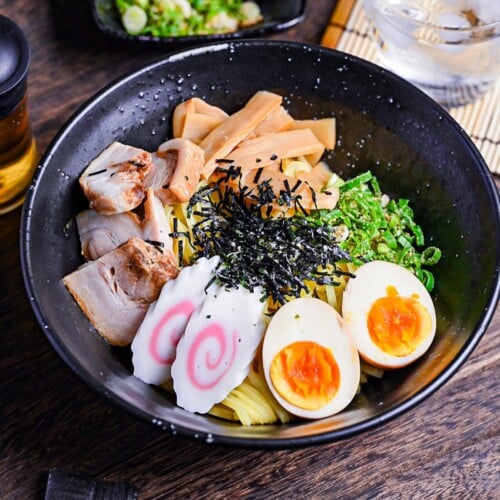
Abura Soba (Soupless Ramen)
Ingredients
Tare (sauce)
- 2 tsp water
- 4 tsp oyster sauce
- 4 tsp Japanese soy sauce (koikuchi shoyu)
- 2 tsp rice vinegar
- 2 tsp toasted sesame oil
- 2 pinches Chinese-style chicken bouillon powder optional
- 1 tsp lard
- 1 tsp garlic paste
- ½ tsp light brown sugar
Abura Soba
- 2 portions ramen noodles fresh or spaghetti hack
- 3 tbsp finely chopped green onions
- ½ tbsp ground sesame seeds
- 1 pinch ground black pepper
- 4 pieces pork chashu or easy oven baked alternative
- 2 ramen egg or soft boiled egg
- seasoned bamboo shoots (menma)
- narutomaki fish cake optional
- roasted seaweed for sushi (nori) to garnish
- chili oil (rayu) to garnish
- rice vinegar to garnish
My recommended brands of ingredients and seasonings can be found in my Japanese pantry guide.
Can’t find certain Japanese ingredients? See my substitution guide here.
Instructions
Mix the Tare
- Add the following to each (microwavable) serving bowl: 1 tsp water, 2 tsp oyster sauce, 2 tsp soy sauce, 1 tsp rice vinegar, 1 tsp sesame oil, a pinch of chicken stock powder, 1/2 tsp lard, 1/2 tsp garlic paste and 1/4 tsp of light brown sugar.

- Mix the sauce and cover the bowls with plastic wrap, then set aside.

Prepping and Assembling the Abura Soba
- Boil 2 portions ramen noodles according to the instructions on the packaging.

- Mix 3 tbsp finely chopped green onions, ½ tbsp ground sesame seeds and 1 pinch ground black pepper together in a bowl.

- When the noodles have 1 minute left of cooking time, place the covered bowls with tare in the microwave and heat for 1 minute on 600W.

- Take the bowls from the microwave and remove the plastic wrap.

- Drain the noodles using a sieve and rinse with fresh hot water to remove excess starch. Divide them between serving bowls, placing them on top of the tare.

- Arrange pork chashu, ramen eggs, bamboo shoots and narutomaki on top of the noodles. Garnish with shredded nori.

- Drizzle with chili oil and rice vinegar to taste, then mix thoroughly before eating. Enjoy!
Video
Notes
- Use fresh or homemade ramen noodles if possible. If not, use my spaghetti hack instead of instant ramen for better texture if needed.
- For large batches, mix sauce ingredients in a jug and divide equally between bowls, increasing microwave time accordingly.
- Mix all ingredients thoroughly before eating to avoid uneven flavor distribution, even if it looks messy.
- Add vinegar and rayu at the beginning before mixing so they combine well with the hot noodles that heat the sauce.
- Eat abura soba while hot, as the texture deteriorates significantly when cooling down.
- Prepare only the amount you plan to eat, as storage is not recommended because noodles become mushy and lose texture.
- Recipes for the components: ramen noodles, pork chashu, ramen egg, and rayu chili oil.
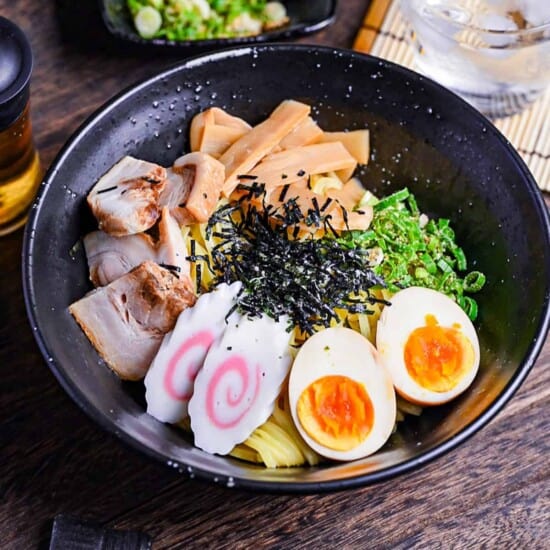




Thank you so much for this awesome recipe! I made it two nights in a row, and I’ll definitely make it more in the future. I live in an area without many choices when it comes to Japanese ingredients, especially ramen noodles, so the spaghetti + baking soda trick is a godsend. I was surprised by how well it works.
Your website is great, looking forward to trying your other recipes!
Hi Robyn! Thank you so much for your kind comment and rating.
I’m happy you enjoyed the recipe!
I also used this spaghetti technique when I was living in England, I’m glad you found it useful too!
There are many abura soba and mazesoba recipes on YouTube and I wish I’d seen yours much earlier because it’s the best and most kitchen friendly. Thanks for making the recipe available for us ramen freaks.
Hi Mike,
Thank you for the comment and your kind words, it means a lot!
I’m so happy that you enjoyed this recipe and the method!
Yuto
I fell in love with this dish during a recent trip to Japan. This recipe was exactly what I was looking for to recreate it at home! Super easy to make and the taste was nearly identical to what I had in Japan (noodles were way better there but that has nothing to do with the recipe). Thanks for sharing this!
Hi Jarrett,
Thank you so much for trying this recipe! I’m really glad to hear that! It means a lot to know the recipe helped bring back a special memory from your trip! 🙂
Yuto